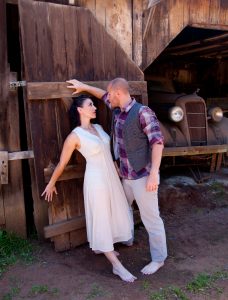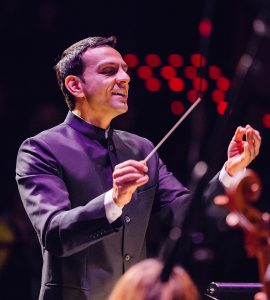‘Snakeskin’ Score an Anthology of Styles
When Malashock Dance and the choral ensemble SACRA/PROFANA announced they were collaborating on a dance project, I imagined ranks of choristers arrayed in a broad semi-circle embracing a cadre of dancers stage center. Sometimes it is better to attend a performance without preconceptions.
The resulting collaboration Snakeskin opened (yes, after a puzzling 30-minute delay) at UC San Diego’s Forum Theater Friday (May 15) sans choir, but with a row of eight instrumentalists—some of whom sang the score’s many solo songs—perched on a raised platform behind the dance stage. SACRA/PROFANA’s director and composer of the Snakeskin score Krishan Oberoi conducted and played, seated in the center of this stage band that ranged from tuba to marimba, with a couple of keyboards tossed in for good measure.
My SanDiegoStory colleague Kris Eitland will review John Malashock’s choreography and the dancers’ virtues in a separate review, so my comments will focus on the music of Snakeskin. Although I have frequently heard SACRA/PROFANA perform since it was formed in 2009, I had not heard Oberoi’s music before, and in an interview prior to the premiere, Oberoi admitted that he had not done much composing since his days as a university student.

Lara Segura and Nicholas Strasburg dance in “SNAKESKIN.”
[photo (c) Yaro Jane Photography]

Conductor Krishan Oberoi, founder of SACRA/PROFANA.
[phhoto courtesy of Malashock Dance]
Scattered throughout the score were six movements of an adroit neo-baroque dance suite that gave it muscle and provided hints of serious compositional potential. But the ballads were another story, alluding to or borrowing in turn from folksong, rock, rhythm and blues, and contemporary musical theater. In “Anchored” from the first act, for example, I heard the rangy melodies of Wicked and in “Blaze of a Bitter Trail” the twang of Appalachian folksong. In “Haven with Your Hands” from the third act, we felt the incessant rhythmic drone and melodic drive of Next to Normal.
It takes any serious composer time to forge a distinctive vocal style, but in Snakeskin Oberoi sounded too much like a deejay trying to please an unusually diverse audience with everything he brought to the gig.
Among the instrumentalist-singers, allow me to praise two vocalists who proved exceptionally communicative and vocally assured, mezzo Courtney Curtis and baritone Jonathan Gonzales.
A few, scattered forays into multivoiced choral commentary added another color to the score, but given the pop leaning of most of the ballads, they seemed to come out of left field—visitors stumbling into the wrong party.
Not every conductor is destined to be a composer, but I’m not ready to crown Oberoi as the next Mahler or Bernstein.

Ken Herman, a classically trained pianist and organist, has covered music for the San Diego Union, the Los Angeles Times’ San Diego Edition, and for sandiego.com. He has won numerous awards, including first place for Live Performance and Opera Reviews in the 2017, the 2018, and the 2019 Excellence in Journalism Awards competition held by the San Diego Press Club. A Chicago native, he came to San Diego to pursue a graduate degree and stayed.Read more…
